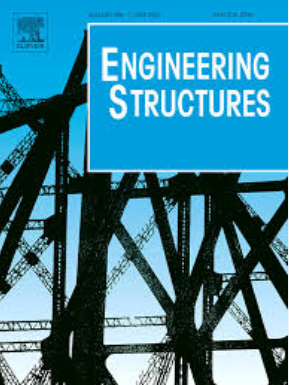Fire-induced spalling in hybrid polyethylene fiber-reinforced engineered cementitious composite panels
IF 5.6
1区 工程技术
Q1 ENGINEERING, CIVIL
引用次数: 0
Abstract
Polyethylene (PE) fibre-reinforced engineered cementitious composites (ECC) offer high ductility and durability, however concerns over fire performance, particularly spalling resistance, continue to limit their adoption. This study evaluates single and hybrid PE fibre-reinforced ECC with high-volume slag and MgO under fire exposure, examining spalling resistance at both material and structural scales. Key test parameters include PE fibre length (9, 12, 18 mm), fibre type (single or hybrid with polypropylene (PP) and basalt fibre), and panel size (300 ×300 mm, 200 ×200 mm, 100 ×100 mm) and thickness (20, 50 mm). A novel 1-directional (1-D) spalling test is also developed and compared with a traditional 3-directional (3-D) furnace test. Material-scale tests showed that replacing 12 mm, 0.75 % PE fibre with basalt improved strength retention at elevated temperatures by approximately 5–7 %, achieving a total retention of 37–40 %. However, large-scale tests revealed poor spalling resistance with this mix as full-thickness spalling occurred in 300 × 300 × 50 mm panels. Spalling resistance improved with longer PE fibres (18 mm) or the addition of PP fibres, with a hybrid mix (12 mm 0.3 % PP, 1.25 % PE, 0.75 % basalt) demonstrating superior performance. Further analysis indicated that fibre melting may not be the primary mechanism for spalling resistance; rather, fibre distribution and bonding with the matrix are critical for forming an effective network for vapour pressure dissipation.
杂化聚乙烯纤维增强工程胶凝复合材料板的火灾剥落
聚乙烯(PE)纤维增强工程胶凝复合材料(ECC)具有高延展性和耐久性,但对防火性能,特别是抗剥落性能的担忧,继续限制了其应用。本研究评估了含有大量炉渣和氧化镁的单一和混合PE纤维增强ECC在火灾暴露下的抗剥落性,并在材料和结构尺度上进行了测试。关键测试参数包括PE纤维长度(9、12、18 mm)、纤维类型(单一或与聚丙烯(PP)和玄武岩纤维混合)、面板尺寸(300 ×300 mm、200 ×200 mm、100 ×100 mm)和厚度(20、50 mm)。开发了一种新型的单向(1-D)剥落试验,并与传统的三向(3-D)炉膛试验进行了比较。材料尺度试验表明,用玄武岩代替12 mm、0.75 %的PE纤维,在高温下的强度保持率提高了约5-7 %,总保持率达到37-40 %。然而,大规模试验表明,该混合料在300 × 300 × 50 mm板中发生全层剥落,其抗剥落能力较差。较长的PE纤维(18 mm)或添加PP纤维可提高抗剥落性能,混合料(12 mm, 0.3 % PP, 1.25 % PE, 0.75 %玄武岩)表现出优异的性能。进一步分析表明,纤维熔融可能不是抗剥落的主要机制;相反,纤维的分布和与基体的结合对于形成有效的蒸汽压力消散网络至关重要。
本文章由计算机程序翻译,如有差异,请以英文原文为准。
求助全文
约1分钟内获得全文
求助全文
来源期刊

Engineering Structures
工程技术-工程:土木
CiteScore
10.20
自引率
14.50%
发文量
1385
审稿时长
67 days
期刊介绍:
Engineering Structures provides a forum for a broad blend of scientific and technical papers to reflect the evolving needs of the structural engineering and structural mechanics communities. Particularly welcome are contributions dealing with applications of structural engineering and mechanics principles in all areas of technology. The journal aspires to a broad and integrated coverage of the effects of dynamic loadings and of the modelling techniques whereby the structural response to these loadings may be computed.
The scope of Engineering Structures encompasses, but is not restricted to, the following areas: infrastructure engineering; earthquake engineering; structure-fluid-soil interaction; wind engineering; fire engineering; blast engineering; structural reliability/stability; life assessment/integrity; structural health monitoring; multi-hazard engineering; structural dynamics; optimization; expert systems; experimental modelling; performance-based design; multiscale analysis; value engineering.
Topics of interest include: tall buildings; innovative structures; environmentally responsive structures; bridges; stadiums; commercial and public buildings; transmission towers; television and telecommunication masts; foldable structures; cooling towers; plates and shells; suspension structures; protective structures; smart structures; nuclear reactors; dams; pressure vessels; pipelines; tunnels.
Engineering Structures also publishes review articles, short communications and discussions, book reviews, and a diary on international events related to any aspect of structural engineering.
 求助内容:
求助内容: 应助结果提醒方式:
应助结果提醒方式:


